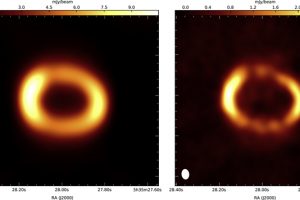The magnetic field in SN1987A revealed from radio observations. The study: “Polarized radio emission unveils the structure of the pre-supernova circumstellar magnetic field and the radio emission in SN1987A” of O. Petruk (INAF-OAPA) appeared on A&A

Without any doubts, the supernova remnants SN1987A is the one that taught us more about this class of objects and supernova exposions. Produced by a supernova exploded in the Large Magellanic Cloud on February 23rd 1987, this is the only case in which we have observations of the progenitor, of the supernova explosion, and in which we follow the development and evolution of the supernova remnant with different telescopes since the beginning. For instance, from SN1987A we learnt how the properties and structure of supernova remnants connect with the nature of the progenitor star, its magnetic field and its circumstellar environment, and how supernova produce dust and relativistic particles are accelerated in supernova remnants.
Radio observations obtained with the Australia Telescope Compact Array (ATCA) and published in 2018 (link), allowed for the first time to measure the polarization (which is the direction of oscillation of the electomagnetic waves) of the radio waves from SN1987A. This is an important piece of information, which allows astronomers to study the direction and topology of the magnetic field in the remnant, and its connection with the configuration of the magnetic field in the progenitor star before the explosion.
Thus, the synthesis of these observations allows astronomers to add another important piece of information about the system before the explosion. To this aim, is however important to compare observations with specific models of the supernova remnant. In the study: “Polarized radio emission unveils the structure of the pre-supernova circumstellar magnetic field and the radio emission in SN1987A” led by O. Petruk (INAF – Astronomical Observatory of Palermo), ATCA observations are compared with a hydrodynamic model of SN1987A, which has been developed by astronomers of the Observatory of Palermo, and has already reproduced all the properties of observed radio and X-ray emission from the supernova remnant. This approach shows that, in order to reproduce the observations, it is necessary that the magnetic field is almost radial. This is possible if the pre-explosion magnetic field can be described as a Parker spiral (introduced by Eugene N. Parker to describe the topology of the solar magnetic field at large distances from the Sun, which is “dragged” by the rotation of our star producing the spiral morphology) with a very weak tangential component. This evidence allowed the authors of the study to define some properties of the progenitor. In particular, during its red supergiant phase (when most of the material forming the circumstellar cloud has been expelled) its rotational velocity should have been weak, and its wind velocity should have been of the order of 3200 km/sec. The study is published on Astronomy & Astrophysics, and it has been signed also by S. Orlando and F. Bocchino of INAF – Astronomical Observatory of Palermo, and M. Miceli of the University of Palermo.
The image (click here to visualize the entire figure) shows the radio image of SN1987A at 22 and 44 GHz, published in the 2018.
Mario Giuseppe Guarcello ( follow mariospiegacose) ( mariospiegacose) ( follow mariospiegacose)
Follow the Astronomical Observatory of Palermo on Facebok
Subscribe the Youtube channel of the Astronomical Observatory of Palermo<
